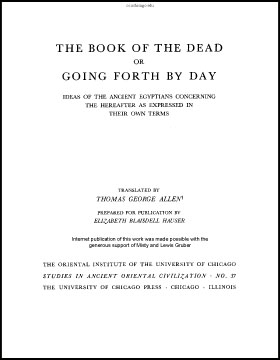SAOC 37. The Book of the Dead or Going Forth by Day: Ideas of the Ancient Egyptians Concerning the Hereafter as Expressed in Their Own Terms Translated by Thomas George Allen

The ancient Egyptians assumed the existence of an afterlife. Desiccated burials in the deserts that so closely hemmed in their fertile valley had early shown how bodies might survive death. Why not likewise the distinctive personality, the soul, the spirit? Thus, compositions were devised to express and bring to pass men's hopes and longings. These could take various forms: hymns, prayers, myths, guidebooks, incantations, even threats against the gods. By Empire times (about 1500 B.C.) such "spells"— as we moderns tend to call them all — had so multiplied that selections from them were commonly assembled on rolls of papyrus to be laid within the coffins. Such a roll constitutes a "Book of the Dead." This too is a modern term, for the Egyptian designation found on the outside of some rolls means "Going Forth by Day." That ancient title emphasized the longing and the hope to return by day from wherever the hereafter might be centered — within the earth or traversing the sky — to visit again at will the familiar scenes of earth. Thence comes the subtitle of the present volume of translations, through which we can listen to the ancient Egyptians' ideas on the nature and problems of the hereafter. It was many decades ago that the basic translations on which we Westerners still depend were made. Meantime, there have been outstanding advances in our understanding of ancient Egyptian vocabulary and grammar, based on results of new excavations, newly found or newly available source documents, more accurate copies of texts previously known, and fresh studies of many aspects of ancient Egyptian life. These cumulative changes call loudly for a new translation of the Book of the Dead. The present writer published in 1960 the Book of the Dead sources available at the University of Chicago. But the two longest and most important papyri are incomplete and much later than those preferred for the present project. Apart from the many additional spells included here, even the few years since 1960 have added to the writer's understanding of his problems. Thus, the reader should feel not disturbed but pleased if he discovers changes here and there from interpretations offered by the earlier book. But certainty cannot always be reached. In Egyptian hieroglyphic and its cursive derivative hieratic script no vowels were written, and the consonantal skeletons frequently permit more than one grammatical form. Even so, translations of the past offer much that has now proved to be grammatically impossible.
- Studies in Ancient Oriental Civilization 37
- Chicago: The Unversity of Chicago Press, 1974
- ISBN: 226-412410-2
- Pp. x + 306
- $10.00

